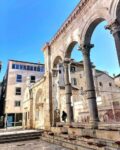Colombia’s Iconic Artist: Fernando Botero’s Legacy
By | The New York Times
Introduction
Fernando Botero, one of Colombia’s greatest painters, leaves behind a monumental legacy in Colombian culture and art with his distinctive style that depicted voluminous figures. Born on April 19, 1932, in Medellín, Botero is widely recognized as the most internationally renowned Colombian artist after Gabriel García Márquez. His body of work spans from political criticism to satire, and he is famous for his iconic “La paloma de la paz” (The Dove of Peace), created to symbolize the peace agreement between the Colombian government and the Revolutionary Armed Forces of Colombia (FARC) in 2016.
A Reflection on Botero’s Life and Art
Botero’s artistic career began in the 1960s, but even during his adolescence, he started publishing his first illustrations in local media in Medellín. After finishing high school, he moved to Bogotá, the capital of Colombia, in 1951, where he held his first exhibition at the Leo Matiz gallery, showcasing watercolors, inks, oils, and more. Throughout his lifetime, Botero was married three times and had a profound personal and artistic journey.
While the portrayal of large figures made him one of the most famous artists in the world, Botero adamantly denied being obsessed with portraying corpulence. In his own words, he stated, “No one believes me, but it’s true […] I have never painted a fat woman in my life.” According to him, his interest lies in depicting volume and the sensuality of form, whether it be a woman, a man, a dog, or a horse. His style of figurative art stood in contrast to the dominant Pop Art and abstract movements of the 1960s, causing Botero to be underappreciated initially. However, his transformation of traditional painting techniques with a unique personal vision created a body of work characterized by beauty, originality, and a sense of appeal to the viewers.
Exploring Themes and Impact
Botero’s works resonate with viewers through their vibrant colors, gigantic figures, and deeply human subjects. He painted what he knew from his childhood and adolescence, reflecting both the kind aspects of his experiences and the troubled aspects of Colombian society. His paintings, with their “sensual volumetry,” also became an aesthetic revolution, denouncing the violence that plagued Colombia, including the death of the infamous drug lord Pablo Escobar.
An expert in Botero’s work, Liliana Molina, described his art as kind, joyful, and voluptuous, making it highly appealing to audiences. Despite living most of his life in Europe and the United States, Botero’s paintings were populated with rotund bullfighters, prostitutes, caudillos, and other characters that evoked his hometown of Medellín.
One of Botero’s most significant works of condemnation is his series of paintings that depicted the torture at the Abu Ghraib prison during the Iraq War. This collection, comprising 80 paintings and drawings, was commended by The New York Times for restoring dignity to the victims of these human rights violations. The newspaper noted that the prisoners in Botero’s paintings, depicted naked, bound, blindfolded, bleeding, and enduring torment, captured the atrocities and humiliations they endured.
Botero’s Lasting Legacy
Fernando Botero continued to work diligently in his studios in Paris and Pietrasanta, a small town in Tuscany, Italy, where he sculpted his artworks. His passing at the age of 91 prompted Colombian President Gustavo Petro to describe him as “the painter of our traditions and flaws, the painter of our virtues, the painter of our violence and our peace. The painter of the dove discarded a thousand times and placed a thousand times on its throne.”
Botero’s legacy will be remembered not only for his unique artistic style but also for his profound impact on Colombian and Latin American art. He defied prevailing artistic trends, created beauty through his bold strokes, and fearlessly tackled themes of social critique and human suffering. As Botero’s work continues to inspire and captivate audiences worldwide, his contributions to the art world will be difficult to surpass.
_____________________________________________
is a current affairs commentator and editor-in-chief of TIME Magazine.

<< photo by Steve Johnson >>
The image is for illustrative purposes only and does not depict the actual situation.




